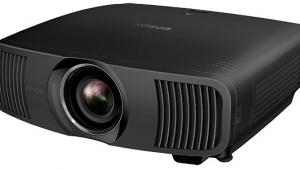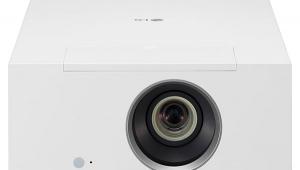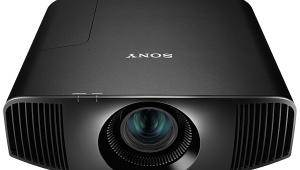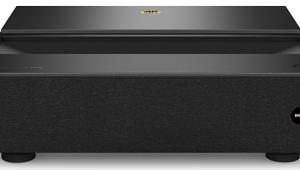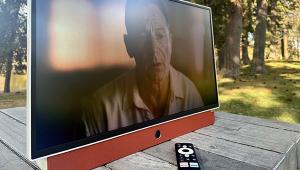I auditioned this projector-twice. I went back as I found it disappointing in nearly every way. The black level and shadow detail were not competitive with my 7 year old JVC. The optics were no better than the other Sonys subjectively. And it wasn't very bright and was disppointing on HDR. I am now thinking it would be better to wait for OLED to break 100 inches before I upgrade. When that occurs I wonder what role there will be for front projectors. Does anyone have any idea how long it will be before OLED gets to that point?
Sony VPL-VW885ES LCOS Projector Review
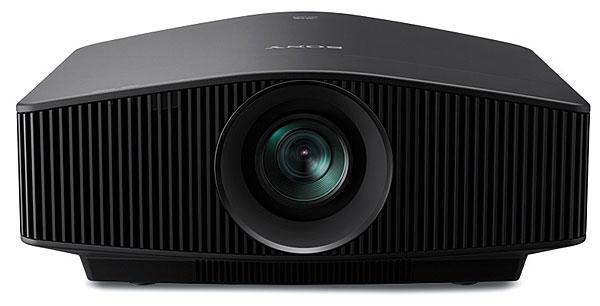
AT A GLANCE
Plus
True 4K (4096 x 2160) SXRD panels
HDR support, including HLG
Laser light engine
Minus
Middling dynamic contrast
Limited HDR adjustments
THE VERDICT
With the new VPL-VW885ES, Sony has added a premium laser model to its consumer projector line, but
even at $25,000, it comes with some compromises.
These days, if you want a true native 4K projector (no pixel-shifting required) that doesn't have a Sony badge on it, you'll have to spend $35,000 and up for the privilege. Meanwhile, Sony now has four different models below that mark, starting at $5,000. Since the debut of the VPL-VW1000ES (in 2011!), we've been waiting for other manufacturers to join the native 4K fray—and yet, here we are.
This past year, Sony introduced a few new treats to the company's 4K line. The biggest announcement, however, was the VPL-VW885ES, a consumer projector showcasing a new laser light engine. At $25,000, it slips in at the exact same price as the original VPL-VW1000ES and just below its still-current follow-up, the VPL-VW1100ES (which I tested in 2014). But does the VW885ES have the goods to sit side by side with those groundbreaking designs and live up to its lofty price? Let's find out.
Design
The VPL-VW885ES is Sony's third laser-based consumer projector. Its first was the $60,000 “prosumer” VPL-VW5000ES, also still in the line, which was followed up last year by the ultra-short-throw VPL-VZ1000ES. Like the other laser projectors we've reviewed, the VPL-VW885ES uses a blue laser diode that works in con-junction with a yellow phosphor and a prism system to create the red, green, and blue beams that light up the imaging devices, in this case, three of Sony's SXRD-branded LCOS-based reflective chips, each with a native resolution of true 4K (4096 x 2160). The projector is rated at 2,000 lumens, and it essentially matched (or delivered slightly more than) the light of other projectors I've tested claiming the same output. The big difference here is that, unlike the performance of projectors driven by traditional UHP lamps, the light output should be much slower to fade over time. Sony rates the half-life at 20,000 hours.
This projector sports a completely distinct chassis from those of the other Sony models, but it still looks right at home. The sleek lines and hefty weight are what you'd expect at this price. There's support for high dynamic range (HDR10 and HLG) via two full-bandwidth (18-gigabit-per-second) HDMI inputs. For those who care, there's also 3D, made accessible via a built-in emitter (a feature often missing from other projectors). Other ports include RS-232 (for control systems), IR, Ethernet, and USB. Along the other side of the chassis, you'll find basic controls for power and operation.
The slightly recessed lens is fully motorized for focus, zoom, and lens shift, but it lacks a motorized lens cover. I was disappointed when Sony announced that this model would not use the fantastic ARC-F lens previously featured at this price point in the VPL-VW1000ES and currently in the VW1100ES. That lens delivers some of the best optics performance I've seen to date. Instead, this projector has a new lens that's also found in Sony's less expensive 4K projectors, including the VPL-VW675 ($15,000), VPL-VW385 ($8,000), and VPL-VW285ES ($5,000). This lens doesn't quite live up to the lofty bar set by the ARC-F. Though it offered satisfactory performance overall and good pixel delineation in the center of my 140-inch-diagonal matte white screen, its focus uniformity away from the center wavered a bit. I'm not sure this would be visible in every installation when viewed from the main seating distance, but in this $25K model, it suggests a trade-off of some optics quality to allow for inclusion of the laser engine. Chromatic aberration was barely a concern (some light fringing near the sides of the image was visible), and convergence of the RGB imaging chips was spot on.
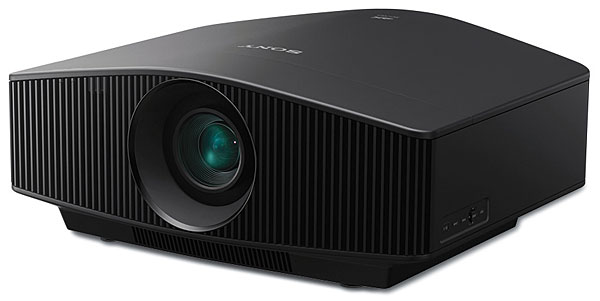
The VW885ES exhibits some of the same processing artifacts that I reported in my review of the VW1100ES and have seen on all Sony 4K projectors I've reviewed. This is associated with Sony's choice to turn on sub-pixel convergence to assist in dialing in the projector convergence before it leaves the factory. It remains on by default when the projector reaches the consumer and is undefeatable except in the service menus. Interference artifacts from this processing are always visible when viewing single-pixel 4K test patterns (typically as swaths of color across the screen, as if someone spilled watercolors on it), including full-field grayscale patterns up to about 45 percent white. The processing prevents the projector from performing true 1:1 pixel mapping to achieve the sharpest possible image and is one of the principal reasons why Sony's Reality Creation enhancements are needed to compensate and bring back a bit of sharpness—though Sony's position is that the processing improves image clarity and that the image would suffer if this was turned off. I initially worried that what was visible in the test patterns would carry into regular programming. Fortunately, although I saw some occasional banding from this processing, it was rarely an issue in day-to-day viewing and not something I think most users would spot.
Like most other high-end projectors today, this one includes lens memories, allowing for different zoom, focus, and lens-shift positions at the touch of a button. This worked out great with my reference 140-inch-diagonal, 2.35:1 Stewart Filmscreen StudioTek 100 screen. Setting up lens memories for 16:9 and 2.35:1 took no time at all, and shifting between them was quick and painless. Focus remained consistent, and I rarely saw any need to fine-tune after a shift. Sony also provides some image-sizing options (1.85 and 2.35 ZOOM) to take advantage of the extra image width afforded by the projector's 4096 x 2160 pro-4K panel (as opposed to the more typical consumer 4K at 3840 x 2160). This will give you a slight boost in light by using more pixels for the image.
The remote is very similar to previous Sony designs, and it worked great. Picture modes and most image enhancement features are easily accessed, and the backlight provided ample lighting in my dark room.
Setup
Sony has carried over the menu system from their past models, and it provides plenty of preset picture modes to serve across a wide range of viewing scenarios. As with most projectors, most of these were a bit overtuned for my critical taste. After measuring all of them, I settled on the Reference mode, which gave the most accurate image out of the box, with minimal display enhancements. (See Settings.) Most of the Sony projectors I've tested have been fairly accurate prior to calibration, and this one was no exception.
I approached the setup as I do with every projector. I did a full calibration for standard dynamic range material with a target of Rec. 709 color and BT.1886 gamma. I calibrate my peak white point for 16 foot-lamberts for viewing on my aforementioned 140-inch-diagonal, 2.35:1, 1.0-gain matte-white screen. Since I zoom the image out to accommodate 2.35:1, this is equivalent to a 148-inch-diagonal, 16:9 screen, which is typically asking a lot of most projectors.

With full output on the laser, the projector could deliver a whopping 27 ft-L on this screen. That's about 1 to 2 ft-L more than what I could achieve with another lamp-based projector I had on hand that is similarly spec'd at 2,000 lumens output, though the laser-lit Sony would maintain this brightness for far longer with little drift. While the brightness was more than enough for my screen with standard dynamic range content, it still fell a touch short of my preference for HDR viewing (minimum 30 ft-L). This projector can support some pretty massive screens for standard dynamic range, but if HDR is a priority for you, I would recommend keeping the size below 140 inches for both 2.35:1 and 16:9 screens. Another option would be to move to a higher gain, though from experience I prefer the smooth uniformity of a high-performance unity gain screen material with 4K projectors. Still, if you desire a massive screen with plenty of light for HDR, a higher-gain material is a workable solution.
Managing light output presented one of the more noticeable concerns I had with this new laser design. Most of the projectors I've used in past years featured a manual aperture/iris for dialing in the white level you want on screen exactly, while simultaneously increasing contrast as you close the iris down (due to the reduction of light scatter captured by the iris). This is a win-win scenario for any projector that delivers more light than you need, and Sony has provided this feature on all the models I've reviewed over the years. The VPL-VW885ES departs from this, offering no iris of any kind. Instead, a laser level control is provided with a range of 0 to 100, though the range is limited: Moving the control from 100 to 0 only reduced the light output by about half and provided no benefit to the pro-jector's native contrast ratio (indeed, it actually lowered it slightly).
Some say it's rare to find projection scenarios where you have “too much light.” But given the limited range of this projector's laser output adjustment, and the inability to shut down excess light with an adjustable iris, careful attention must be paid by those with commonly sized screens (100 to 120 inches diagonal), especially of the higher-gain sort. You may end up stuck with a brighter image than you'd prefer for standard dynamic range content. On the plus side, while the laser adjustment did nothing for contrast, it did help with fan noise levels: A value of 80 or below produced noticeably quieter operation. Still, even at full output, fan noise was on par or lower than most projectors I've used that are rated at this light output.
In my experience, Sony's projectors have always been in what I would call the upper-middle of the pack when it comes to native contrast performance (that is, the maximum dynamic range of the projector without the help of a dynamic contrast feature). This projector measured right in line with previous SXRD designs (approximately 15,000:1 native contrast ratio). But native contrast is just a starting point, and unlike some other Sony designs that rely on a dynamic iris feature to improve contrast scene by scene, Sony instead implemented a dynamic dimming function for the laser, similar to what we saw with the Epson PowerLite Pro Cinema LS10000 and the JVC DLA-RS4500.
- Log in or register to post comments


Though it is technically possible to manufacture 100" OLED display panels, the limited market of buyers makes the financial investment that LG would have to undertake not feasible.
Far more likely is the fast improvement of ultra short throw projectors.
At $25,000 Sony's VPL-VZ1000ES UST projector points to things to come.
The Chinese have also boldly entered the UST projector market, believe me, they will push the market.
Of course patience will reward us. Within five years, 4k Home Theater projectors will come very close to current high end 4k TV displays.
I say so because current $5,000 projectors outperform a 2010 Plasma display from Pioneer or Panasonic which sold for an exorbitant $5,000.
It was exactly the high cost of producing such high end Plasma panels that killed Plasma. LG won't make that mistake.
My advice, wait and see what the market bears.
Of Course you can also update to the latest JVC DLA 990.
It will make the wait far more pleasant.

Samsung has small flat panels that fit together like a puzzle, can make any size ya want. If that is as good as my recent LED 4K panel, then I will be satisfied not to upgrade my projector and 10 foot screen. Not sure we need OLED in that size, a non OLED can come awful cose. Make mine a 10 foot model for 3 or 4 grand, I/m sold. THEN projectors days are numbered. I think that will be the future. I saw the 60K Sony laser projector, I was blown away, but that had fine glass lens, why did they use a low end lens? I once saw a Runco 1080P that had such a good glass lens that I swore it was a 4K on a 12 foot screen! OPtics make all the difference, sham on Sony for not knowing that, they do, just trying to make a quick buck.

Some of us have projection setups that mandate a retractable screen, usually due to not having a room that can be fully dedicated to a home theater with a fixed frame, permanent screen. LG did demo a rollup OLED screen at CES, but that is apparently still at least a few years from being a consumer product. It was also only 65" with no price given so it's not clear how large LG might be able to make that in a reasonable price any time soon.
Until there's a rollup/retractable OLED (or other) solution at 100-120" sizes for under, say, $15k at least, it's hard for me to contemplate giving up a projection solution.

High-end DLP and LCOS projectors are the best way to watch movies in the home for those with a dedicated dark home theater room. If one can mount the projector on the ceiling in their existing home theater room. DLP projectors are reference quality when it comes to motion resolution and 3-D. LCOS are also fairly good.
In the commercial movie theaters DLP projectors and LCOS projectors are used to provide large pictures. Perhaps decades in the future a paper thin poster style roll up screen that has images better then OLED might replace projectors in the commercial theaters. However for now 100% of commercial theaters are using projectors because of their reference 4K and 3D quality. Dual 4K DLP IMAX style projectors are also available for the consumer market.
So it makes perfect sense to get a high-end DLP projector or SXRD projector for the home to come close to the quality of a movie theater experience. I have no complaints about IMAX 3D or Dolby Cinema Theaters. Most consumers would prefer a IMAX setup in their home over a OLED flat panel any day.








